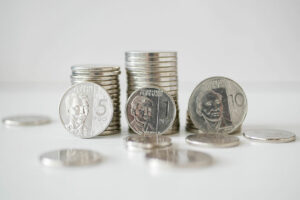




Quarterly Economic Growth Release: More BSP cuts to come
 DOWNLOAD
DOWNLOAD

Monthly Economic Update: Fed catches up
 DOWNLOAD
DOWNLOAD

Inflation Update: Steady and mellow
 DOWNLOAD
DOWNLOAD


Peso tumbles to PHP 56:USD 1 level

THE PESO closed at the PHP 56-per-dollar level for the first time this year on Tuesday due to concerns over a narrowing differential amid a potential pause in the Bangko Sentral ng Pilipinas’ (BSP) tightening cycle while the US Federal Reserve continues to raise rates.
The local currency closed at PHP 56.14 versus the dollar on Tuesday, declining by 29 centavos from Monday’s PHP 55.85 finish, data from the Bankers Association of the Philippines’ website showed.
This was the peso’s first time to finish at the PHP 56 level and worst close in more than three months or since ending at PHP 56.20 on Dec. 28, 2022.
The local unit opened Tuesday’s session at PHP 56 per dollar. It recorded an intraday best of PHP 55.98, while its worst showing was at PHP 56.23 versus the greenback.
Dollars traded rose to USD 1.418 billion on Tuesday from the USD 1.375 billion recorded on Monday.
The peso continued to weaken amid hints of a pause in the BSP’s rate hikes as early as next month, a trader said in a Viber message.
“Probably this time, some players were caught short-squeezed given the strength of upward move. A pause from the BSP but the Fed is still poised to hike [will result in] a narrower yield differential,” the trader said.
The central bank may consider pausing its monetary tightening next month if inflation does not pick up in April, BSP Governor Felipe M. Medalla said last week.
Mr. Medalla said a pause in interest rate increases was possible “if the April CPI (consumer price index) is not higher than the March CPI” or if there is “zero or negative month-on-month inflation.”
Headline inflation eased for a second consecutive month in March to 7.6% from 8.6% in February.
For the first quarter, inflation averaged 8.3%, higher than the BSP’s 6% forecast and 2-4% target for the year.
The Monetary Board last month hiked benchmark interest rates by 25 basis points (bps), bringing the yield on its overnight reverse repurchase facility or its key rate to 6.25%.
Since May 2022, the BSP has raised borrowing costs by a total of 425 bps. Its next meeting is on May 18.
Meanwhile, the US central bank has hiked borrowing costs by a total of 475 bps since March 2022, with the fed funds rate now at a range between 4.75% and 5%.
The Fed’s next policy meeting will be held on May 2-3.
“The peso weakened anew following reports that US House Republicans have secured legislative support to temporarily suspend the US debt limit,” a second trader said.
US House of Representatives Speaker Kevin McCarthy on Monday outlined spending cuts he said his fellow Republicans would demand in exchange for voting to raise the federal government’s USD 31.4-trillion debt ceiling, avoiding a potentially catastrophic default, Reuters reported.
His proposals included cutting spending to last year’s levels, capping growth at 1% per year and reversing some of President Joseph R. Biden’s policy goals, ideas that Republicans, who control the House, have been floating for weeks that have been rejected by Democrats, who control the Senate and White House.
The peso continued to decline as the dollar lingered among one-month highs and against a stronger Japanese yen, Rizal Commercial Banking Corp. Chief Economist Michael L. Ricafort said in a Viber message.
The dollar index fell 0.3% to 101.76 on Tuesday, while the dollar dropped by 0.2% to 134.28 Japanese yen.
For Wednesday, the peso could rebound against the dollar ahead of potentially better inflation data out of Europe, the second trader said.
The second trader expects the peso to trade between PHP 56.00 and PHP 56.25 per dollar on Wednesday, while the first trader gave a PHP 55.85 to PHP 56.40 forecast range. For his part, Mr. Ricafort sees the peso moving from PHP 56.05 to PHP 56.25. — By AMCS with Reuters
This article originally appeared on bworldonline.com





 By BusinessWorld
By BusinessWorld